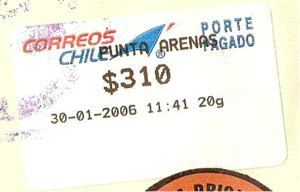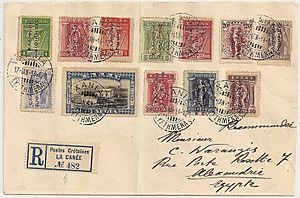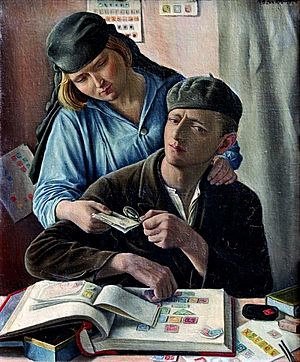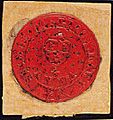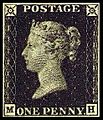Mail facts for kids
Mail is a key part of the postal system. This system helps send written messages and small to medium packages all over the world. Anything you send through this system is called mail or post.
Postal services can be run by private companies or by the government. Since the early 1800s, most national postal systems have been controlled by governments. People usually pay a small fee to send something. This fee is often paid using stamps. Some governments only let private companies deliver larger packages, not letters.
Postal systems often do more than just send letters. In some countries, they also manage telephone and telegraph systems. Post offices in other countries can help people apply for government papers like passports or driver's licenses. Many post offices also work like banks. This means people can take out money or pay bills at a nearby post office. This saves them a trip to a big bank in a town far away.
People drop their letters into a post box. Then, the post office collects these letters and delivers them to the right addresses.
Contents
Types of Mail
Letters
Letters are a big part of what postal services send. These are usually documents printed on standard paper sizes like A4 or Letter size. They are then put into envelopes.
Long ago, handwritten letters were the main way people far apart talked to each other. Now, we have faster ways like phones and email. But traditional letters are still used when someone wants to be thoughtful. For example, sending a letter of sympathy to someone who has lost a loved one.
Many bills and invoices from companies are still sent by mail. These often include an envelope so you can easily send your payment back. While still common, many people now pay bills online. This means they don't need to get bills in the mail anymore. Important papers for big money deals, like tax documents, are also often sent through the mail.
New credit cards and their secret PINs are sent by mail. For safety, the card and the PIN are usually mailed separately. They arrive a few days or weeks apart.
Bulk mail is mail prepared for sending many copies at once. It often gets a lower price. This type of mail is used for direct marketing and advertising mail. Companies might buy lists of addresses to send letters advertising their products. Local businesses also send out ads, like a restaurant advertising its delivery service. Companies also send bulk mail to their current customers to tell them about new products.
First-Class Mail
First-Class Mail in the U.S. includes postcards, letters, large envelopes, and small packages. Each piece must weigh 13 ounces or less. This mail gets delivered faster than other types, like newspapers or bulk ads. The price depends on the shape and weight of the item. If something is over 13 ounces, it can be sent as Priority Mail. In the UK, the Royal Mail's 1st Class is similar. It's a faster option than 2nd Class, but costs a bit more. Royal Mail tries to deliver all 1st Class letters the day after they are posted. Canada Post calls its similar service Lettermail.
Registered and Recorded Mail
Registered mail lets you track where your letter is and makes sure it gets delivered correctly. It costs more than regular mail. People usually use it for valuable items. Registered mail is tracked at every step of its journey.
Recorded mail is handled like normal mail, but someone must sign for it when it arrives. This is helpful for legal papers where you need proof that the document was delivered. In the United Kingdom, recorded delivery mail is called signed for by the Royal Mail.
Postal Cards and Postcards
Postal cards and postcards are small message cards sent without an envelope. A "postal card" usually has the stamp already printed on it and is issued by the postal service. A "postcard" is usually made by a private company and needs a separate stamp. Postcards often have pictures of tourist places or funny messages on the front. You write a short message on the back. Sending a postcard usually costs less than sending a letter.
Magazines also use postcards for new subscriptions. Many magazines have cards inside that you can fill out and mail back to get a subscription. Magazines also use postcards for surveys or contests.
Sometimes, charities send postcards to their members. These cards might have a message for the member to sign and send to a politician. This helps promote causes like fair trade.
Other Mail Services
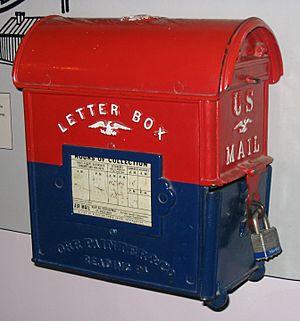
Larger envelopes are also sent through the mail. These are often made of stronger material than regular envelopes. Businesses use them to send documents that should not be folded, like legal papers. Because they are larger, these envelopes sometimes cost more to send.
Packages are often sent through postal services. They usually cost more than a letter or postcard. Many postal services have rules about what you can send in a package. They often ban things that are easily spoiled, dangerous, or can catch fire. Some dangerous items can be shipped in small amounts if they are marked and packed correctly. Also, because of safety concerns, postal services often scan or x-ray packages. They look for things that might be dangerous.
Newspapers and magazines are also sent by mail. Many magazines are just mailed normally. Some are shipped in shrinkwrap to protect them. In the past, newspapers and magazines were often sent using special paper wrappers with a stamp printed on them.
Hybrid mail is when you send mail from your computer directly to a postal service. The postal service then uses computers to sort and send your mail to a printing place closest to where it needs to go. Then, it's printed and delivered. This is becoming more popular. In some countries, these services can even print and deliver emails to people who don't have email, like older adults.
Collecting
Postage stamps are often collected as a hobby. Stamp collecting is a very popular hobby. Sometimes, if many people want a certain stamp, its value can become much higher than what it was used for. For some postal services, selling stamps to collectors who will never use them is a good way to make money. This happens with stamps from places like Tokelau or Tristan da Cunha.
Another thing people collect is postcards. These are messages written on a single strong piece of paper. They usually have photos or art on one side and a short message on the other. There's also space for the address. Postcards are different from postal cards, which have the stamp already printed on them.
Related pages
- Clapper Post
- Electronic mail
- Envelope
- Letter (paper)
- Letter box
- Postcard
- Telegram
- Post office box
- Post box
Images for kids
-
A postman collecting mail for delivery
-
Many early post systems used fixed routes. This is a post house in 19th century Finland.
-
The Scinde Dawk stamp was first used on July 1, 1852, in the Sindh district. It was part of a big change to the postal system there.
-
China 4-cent on 100-dollar silver overprint of 1949
-
Delivery by bicycle in Germany
-
The Penny Black, the world's first postage stamp
-
The first airmail flight in Germany, 1912
-
In the United States, private companies like FedEx and UPS compete with the government's United States Postal Service. They mainly compete for package delivery. Different mailboxes are used for local and express service.
See also
 In Spanish: Correo postal para niños
In Spanish: Correo postal para niños


